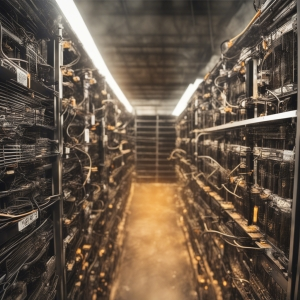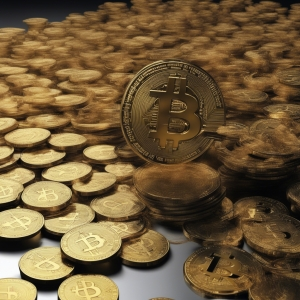Table of Contents:
Introduction to Bitcoin Mining Pools and Fees
For many newcomers, the world of Bitcoin and cryptocurrency can seem complicated and daunting. But, the reality is much simpler once you understand the basics. In this article, we will focus on the topic of Bitcoin mining pools, and most importantly, their fees - a critical aspect often overlooked. By the time you finish reading, you will have a clear view of how Bitcoin mining pools operate and why the aspect of fees becomes crucial to maximize your crypto earnings.
Bitcoin Mining is a way to earn bitcoins, and a mining pool is a method to do it more efficiently. It's a group of miners who combine their computing power to increase their chances of earning bitcoin. Fees are a critical part of this ecosystem. Miners pay these fees to join the pool and in return, they get a share of the bitcoins mined by the pool. Understanding how these fees work can help you choose the right pool and increase your bitcoin earnings.
Get $500 free Bitcoin mining for a free testing phase:
- Real daily rewards
- 1 full month of testing
- No strings attached
If you choose to buy after testing, you can keep your mining rewards and receive up to 20% bonus on top.
The costs associated with Bitcoin mining can be daunting, but proper knowledge and understanding can lead to a more efficient and profitable experience. Stay tuned as we delve deeper into this fascinating world of Bitcoin Mining pool fees.
Understanding the Concept of Mining Pool
The first thing we need to cover is what a Bitcoin mining pool actually is. In simple terms, think of a mining pool as a team of miners working together. These miners engage in complex computational work to solve mathematical problems associated with Bitcoin transactions, which is called "mining". Together, they pool their computing resources to mine Bitcoin blocks more efficiently.
Bear in mind that successful Bitcoin mining requires a substantial chunk of hardware and processing power. Mining alone can be a difficult and lengthy process, with a small chance of earning Bitcoin. Hence, the concept of a mining pool is particularly significant for those who cannot afford large-scale mining setups.
Mining pools help miners achieve more consistent payouts as the rewards are split amongst the pool members. This advantage, however, comes at a cost called the 'mining pool fee'. The primary goal of the miner becomes to earn more than they spend on these fees to keep the endeavor profitable.
Therefore, fully understanding each pool's fee structure is imperative before making a commitment. Some pools have flat fees, while others have a percentage-based structure. The key is to select a pool with a balance of low costs and high rewards.
Analysis of Bitcoin Mining Pools: An Overview of Fees and Rewards
| Mining Pool | Fees (%) | Rewards System | Pros | Cons |
|---|---|---|---|---|
| Antpool | 2.5 | PPLNS | No fee in PPLNS mode | Payment threshold is high |
| SlushPool | 2.0 | Score-based | User-friendly interface | Some complaints about support |
| F2Pool | 3.0 | PPLNS | Good reputation | High withdrawal fees |
| BTC.com Pool | 1.5 | FPPS | Low withdrawal limit | Higher fees on smaller payouts |
| Poolin | 2.0 | PPS+ | Low minimum payout | Lower efficiency on some coins |
Evaluating the Impact of Fees on Bitcoin Mining

The cost of participating in a Bitcoin mining pool is not free, which comes in the form of mining pool fees. These expenses play a significant role in the overall profitability of your mining endeavor. The impact of fees in mining is often underestimated and the effect it can have on the bottom line should not be taken lightly.
Keep in mind, as a miner, your aim is not just to mine bitcoins but to retain a significant percentage of your earnings. This is where the impact of fees comes into the picture. Higher fees reduce your income while lower fees mean you retain more of your revenue. Therefore, when choosing a mining pool, it’s not just about the size or reputation of the pool but also the pool fees associated with it.
When evaluating different mining pools, make sure to look at the details of their fee structure. Some pools charge a flat fee, while others charge a percentage of your mining rewards. Some may also incorporate additional charges for certain services during mining. Understanding these intricate details will ensure you are aware of what you are signing up for, thus, avoiding any unpleasant surprises down the line.
Let it be clear, in the world of bitcoin mining, every satoshi counts. Therefore, even the smallest consideration towards fee reduction can lead to a significantly improved overall return on investment.
Unraveling the Reward System in Bitcoin Mining Pools
One of the key elements that influence the choice of a mining pool is the reward system they offer. The rewards you receive from a mining pool are your portion of the total bitcoins mined by your pool. Different Bitcoin mining pools have varying reward systems, all of which have a different impact on your potential earnings.
Popular reward systems include Pay Per Share (PPS), Proportional (PROP), and Pay Per Last N Shares (PPLNS). The Pay Per Share model means that you get paid for your submitted shares, irrespective of whether a block is found or not. In the Proportional system, your rewards are proportional to the number of shares you submit during a round. On the other hand, PPLNS awards miners based on the last N shares submitted, regardless of round boundaries.
Each reward system has its pros and cons, and you must choose one that suits your mining goals. For instance, PPS is straightforward and guarantees a steady income but usually comes with higher fees. PROP, while fair to all miners, is susceptible to 'pool hopping', where miners only participate in the most profitable rounds. PPLNS is immune to pool hopping and rewards loyal miners but can be quite unpredictable.
However, beyond understanding the reward system, it is essential to take into account the fees associated with each system. A higher reward system that comes with high fees may not always be the most profitable option. Always balance the potential rewards against the Bitcoin Mining Pool Fees to ensure that you are maximizing your profit.
Choosing the Right Bitcoin Mining Pool: Fees and Other Factors

When it comes to selecting a bitcoin mining pool, there are several factors to consider. Your choice of pool influences your potential earnings and overall Bitcoin mining experience.
The first and perhaps most essential aspect to consider is the mining pool fees. The lower the fee, the more profits you retain. Be cautious, however, when you encounter mining pools offering very low fees, as they might not be able to provide a steady flow of rewards. A balance must be struck between low fees and consistent payouts. Always remember to delve into the specifics of the fee structure and to avoid any hidden charges.
Another crucial factor to consider is the reward system of the mining pool. Analyze the different reward systems and select the one that best suits your needs and mining power. Traditional methods like PPS, PROP, or PPLNS each come with their advantages and downsides.
The pool’s reputation and size also matter as they can impact payout frequency. Larger, more established pools give out more consistent rewards, while smaller pools tend to offer larger but less frequent payouts.
In addition, consider the mining pool's server reliability and security features. A stable server ensures your mining operations run smoothly, and good security measures protect your earnings.
Last but not least, ensure the pool supports the mining hardware and software you are using. Compatibility issues can lead to inefficiencies and losses.
Considering all these factors together will guide you in choosing the most suitable Bitcoin mining pool, increasing your chances of having a profitable and successful mining experience.
Benefits of Joining a Bitcoin Mining Pool
Joining a Bitcoin mining pool can have several advantages for cryptocurrency miners. One of the main benefits is the potential for more consistent income. Mining alone comes with substantial fluctuation in rewards as you only earn when you mine a block successfully. In contrast, mining pools see a more constant influx of rewards, divided among participants based on their contribution.
Another advantage is reduced variance. Mining Bitcoin is, after all, based on a lottery system where luck and computational power play major roles. By joining a pool, you're decreasing the 'luck' factor and reducing the unpredictable nature of mining returns. This is a great advantage for those who prefer stability over the 'boom or bust' nature of solo mining.
Furthermore, mining pools often provide user-friendly interfaces and a community of miners. Tools for tracking hash rate, uptime, and other statistics make it easier for new miners to get started. On the other hand, the sense of community can provide help and advice, making the mining process less daunting for beginners.
The culmination of these benefits can lead to more consistent profits, making the cost of pool fees a worthwhile investment for many.
Conclusion: Weighing the Costs and Rewards of Bitcoin Mining Pools

To wrap up, when embarking on the journey of Bitcoin mining, joining a mining pool can leverage your efforts by providing a collaborative platform for mining. These mining pools enhance the productivity of Bitcoin mining and improve the overall chances of achieving a reward.
However, it is essential to acknowledge that every mining pool has its fee structure. These fees pose as an expense that needs to be offset against earned mining rewards. Therefore, wise judgement in choosing a pool with fair and manageable fees is of the utmost importance to ensure profitability.
Simultaneously, understanding the reward system of a mining pool is another essential consideration. By understanding systems like PPS, PROP, or PPLNS, you can identify which pool aligns with your earning goals and choose accordingly.
As cutting-edge as the world of Bitcoin mining can be, it is, ultimately, a matter of strategic planning and informed decision-making that lead to success. Keep in mind that every fee spent and reward earned contributes to your bottom line. Carefully evaluating these elements will not only boost your Bitcoin mining efforts but also ensure a profitable venture.
Sorry, ich habe die Subüberschrift nicht gesehen. Könnten Sie diese bitte auf Englisch wiederholen?
Bitcoin Mining Pools: Ein Überblick über Gebühren, Belohnungen und mehr
Was ist ein Bitcoin Mining Pool?
Ein Bitcoin Mining Pool ist ein Netzwerk von Bitcoin Minern, das zusammenarbeitet, um eine Blocksuche schneller zu lösen. Der Pool teilt die Belohnung entsprechend der zur Verfügung gestellten Verarbeitungsleistung auf die Teilnehmer auf.
Wie funktionieren die Gebühren in einem Bitcoin Mining Pool?
Die meisten Pools erheben eine Gebühr, die ein Prozentsatz der Bitcoin-Belohnung ist, die der Miner erhält. Diese Gebühren dienen dazu, die Kosten des Pools zu decken.
Was sind die Belohnungen in einem Bitcoin Mining Pool?
Die Belohnung in einem Bitcoin Mining Pool ist ein Anteil an der Bitcoin-Belohnung, die dem Pool als Ganzes vergeben wird, wenn er einen Block findet. Die Höhe des Anteils basiert auf der Rechenleistung, die jeder Miner beiträgt.
Was ist der Vorteil von Bitcoin Mining Pools?
Der Hauptvorteil eines Mining Pools ist die regelmäßige Auszahlung. Während Allein-Mining oft unbeständige Belohnungen hat, bieten Mining Pools eine stabilere und vorhersehbare Einkommensquelle.
Lohnt sich das Mining im Pool für jeden?
Ob sich Mining im Pool lohnt, hängt von verschiedenen Faktoren ab, darunter der Preis von Bitcoin, der Schwierigkeitsgrad des Minings und die Stromkosten. Es ist wichtig, diese Faktoren zu berücksichtigen, bevor Sie sich für das Pool-Mining entscheiden.






